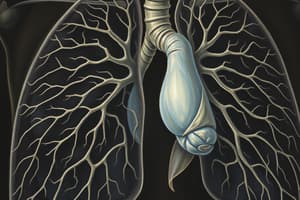Podcast
Questions and Answers
What is the role of the respiratory system?
What is the role of the respiratory system?
The respiratory system is responsible for the exchange of gases between our body and the environment.
Describe the function of alveoli in the respiratory system.
Describe the function of alveoli in the respiratory system.
Alveoli are tiny air sacs in the lungs that provide a highly efficient interface for gas exchange.
How is carbon dioxide transported from cells to the lungs?
How is carbon dioxide transported from cells to the lungs?
Carbon dioxide is primarily transported in the blood as bicarbonate and dissolved CO2.
What is the main function of the alveoli regarding gas exchange?
What is the main function of the alveoli regarding gas exchange?
Explain the significance of the dense network of blood capillaries around alveoli.
Explain the significance of the dense network of blood capillaries around alveoli.
Explain the role of hemoglobin in oxygen transport.
Explain the role of hemoglobin in oxygen transport.
Describe the process of gas exchange in the alveoli.
Describe the process of gas exchange in the alveoli.
How does the body regulate oxygen and carbon dioxide levels in the blood?
How does the body regulate oxygen and carbon dioxide levels in the blood?
Explain Dalton's Law of Partial Pressures and its relevance to gas concentration in the alveoli and blood.
Explain Dalton's Law of Partial Pressures and its relevance to gas concentration in the alveoli and blood.
What is the role of bicarbonate and hydrogen ions in the transportation of carbon dioxide in the blood?
What is the role of bicarbonate and hydrogen ions in the transportation of carbon dioxide in the blood?
Flashcards are hidden until you start studying
Study Notes
Human Gas Exchange: Exploring the Respiratory System, Alveoli, and Gaseous Transport
Gas exchange within our body is a vital, life-sustaining process that enables the continuous flow of oxygen (O2) into our cells and the removal of carbon dioxide (CO2) as a waste product. The human respiratory system, along with its specialized structures like the alveoli, plays a crucial role in facilitating this exchange.
The Respiratory System
The respiratory system is responsible for the exchange of gases between our body and the environment. It comprises two main components: the lungs and the respiratory tract. The respiratory tract includes the nose or mouth, pharynx, larynx, trachea, bronchi, and bronchioles, which all work together to transport air to and from the lungs.
The Alveoli
The lungs contain millions of tiny air sacs called alveoli. These sacs are surrounded by a dense network of blood capillaries, forming a highly efficient interface for gas exchange. The alveoli are designed to maximize the surface area in contact with the blood for the efficient diffusion of gases.
Carbon Dioxide Transport
Carbon dioxide, a waste product of cellular metabolism, is transported from cells to the lungs via the bloodstream. The primary transporters of CO2 in the blood are bicarbonate (HCO3-) and carbon dioxide (CO2). Carbon dioxide dissolves in plasma and forms carbonic acid (H2CO3) with the help of the enzyme carbonic anhydrase. The carbonic acid then dissociates into bicarbonate (HCO3-) and hydrogen ions (H+). The bicarbonate ions are transported in the blood, while the hydrogen ions are buffered and transported back to cells.
Oxygen Transport
Oxygen is transported from the lungs to cells via hemoglobin, a protein found in red blood cells. Hemoglobin binds to oxygen with high affinity, forming oxyhemoglobin, which is then transported to cells. Oxygen dissociates from oxyhemoglobin in the tissues, where it is used for cellular respiration. Hemoglobin then releases carbon dioxide to be transported back to the lungs, completing the cycle.
Gas Exchange Mechanisms
Gas exchange occurs as oxygen and carbon dioxide diffuse across the alveolar and capillary walls. Oxygen moves from the alveoli into the blood, while carbon dioxide moves in the opposite direction. The exchange of gases is a passive process, driven by the concentration gradient. Oxygen moves from an area of higher concentration (the alveoli) to an area of lower concentration (the blood). Similarly, carbon dioxide moves from an area of higher concentration (the blood) to an area of lower concentration (the alveoli).
Partial Pressure is the measure of the concentration of a gas in a mixture. The Dalton's Law of Partial Pressures states that the total pressure of a gas mixture is equal to the sum of the partial pressures of its individual components. This law helps us understand that the concentration of gases in the alveoli and the blood is influenced by their partial pressures.
Oxygen and Carbon Dioxide Levels Regulation
The body constantly monitors the partial pressures of oxygen (PaO2) and carbon dioxide (PaCO2) in the blood. The brain controls the rate and depth of breathing to maintain optimal levels. This process ensures that cells receive the oxygen they need for cellular respiration and that carbon dioxide is removed efficiently, preventing the accumulation of waste products.
In summary, the human respiratory system, in conjunction with specialized structures like the alveoli, plays a critical role in gas exchange. The transportation of carbon dioxide and oxygen is facilitated by the unique properties of hemoglobin and the diffusion of gases across the alveolar-capillary membrane. The body continuously regulates the levels of oxygen and carbon dioxide to maintain a healthy equilibrium.
Studying That Suits You
Use AI to generate personalized quizzes and flashcards to suit your learning preferences.




